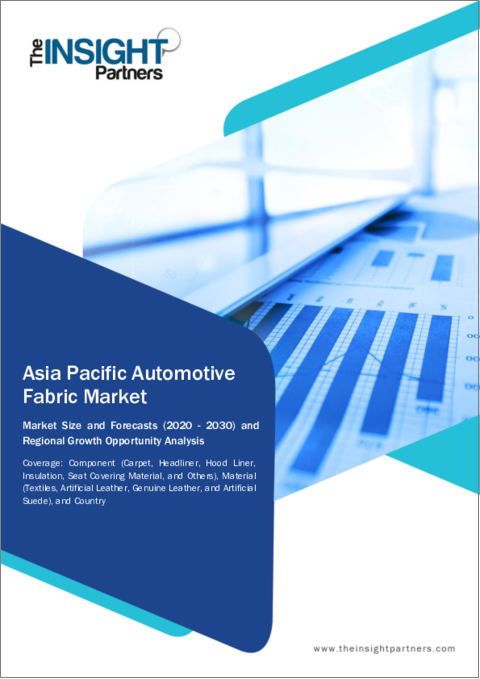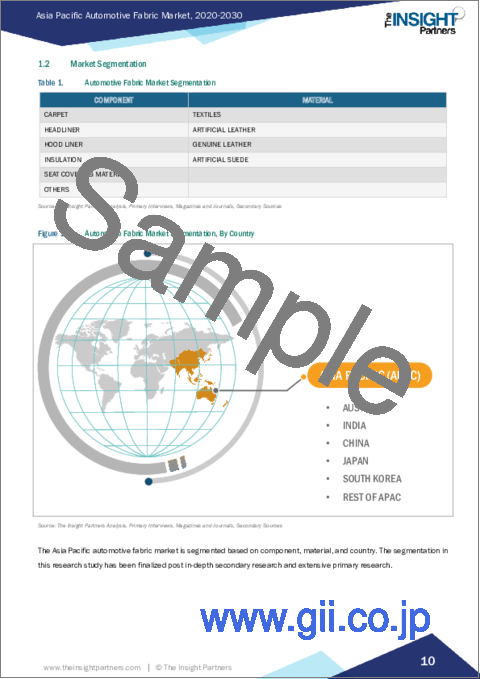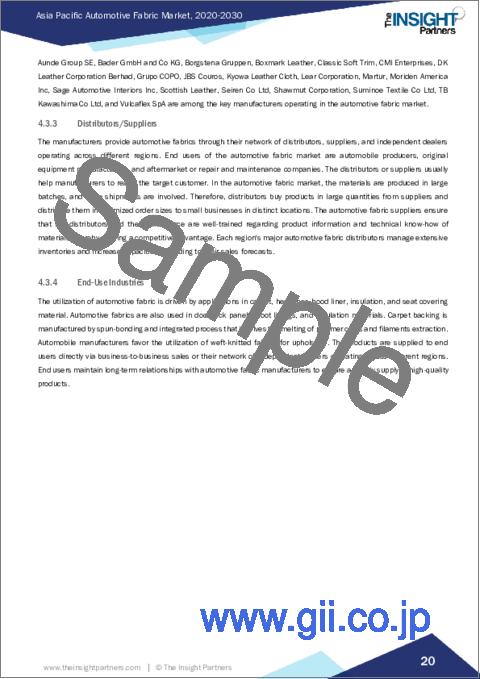|
|
市場調査レポート
商品コード
1494418
アジア太平洋地域の自動車用ファブリック:2030年市場予測- 地域別分析- 構成部品別、素材別Asia Pacific Automotive Fabric Market Forecast to 2030 - Regional Analysis - by Component (Carpet, Headliner, Hood Liner, Insulation, Seat Covering Material, and Others) and Material (Textiles, Artificial Leather, Genuine Leather, and Artificial Suede) |
||||||
|
|||||||
| アジア太平洋地域の自動車用ファブリック:2030年市場予測- 地域別分析- 構成部品別、素材別 |
|
出版日: 2024年03月14日
発行: The Insight Partners
ページ情報: 英文 70 Pages
納期: 即納可能
|
全表示
- 概要
- 図表
- 目次
アジア太平洋地域の自動車用ファブリック市場は、2022年には243億1,691万米ドルとなり、2030年には365億7,223万米ドルに達すると予測され、2022年から2030年までのCAGRは5.2%で成長すると予測されています。
自動車用ファブリック産業における革新的技術開拓がアジア太平洋地域の自動車用ファブリック市場を後押し
多くのメーカーが自動車用ファブリック関連の製品革新に取り組んでいます。需要と供給能力の増加に対応するため、メーカーは様々な法的要件や消費者要件を取り入れ、環境に優しく、技術的に先進的で、法的に承認されたファブリック素材を発売しています。汚れ、水、紫外線に対する耐性を提供するコーティングの開発は、自動車用ファブリックの外観と耐久性の維持に役立っています。顧客の安全を確保しながらエアバッグを搭載できるファブリックを開発するための絶え間ない研究開発により、破れにくい素材とシームレスな統合の開発が促されています。さらに、柔軟性、快適性、伸縮性、視覚的品質の向上により、ニットファブリックや織物ファブリックが多く使用されるようになり、このようなファブリックの需要が高まっています。メーカーは、最小限の含水率を有し、高度な接着技術と統合された軽量複合材料を好み、自動車の密閉性、振動、過酷さを調整します。また、騒音や振動を吸収するために床材に布地を使用することで、全体的な顧客体験が向上します。このように、自動車用ファブリック産業における革新的な技術開拓の増加は、今後数年間、市場にいくつかの成長機会を生み出す可能性が高いです。
アジア太平洋地域の自動車用ファブリック市場概要
アジア太平洋地域には、トヨタ自動車、タタ・モーターズ、現代自動車、日産自動車、本田技研工業などの大手自動車会社があります。中国乗用車協会(China Passenger Car Association)が発表した報告書によると、2022年にはテスラ・インクが8万3,135台の中国製電気自動車を納入し、2021年からの電気自動車販売の伸びを示しています。国際自動車工業会の報告書によると、2021年のアジア太平洋地域の自動車生産台数は4,673万台と推定されています。さらに、同地域の乗用車生産台数は2020年の3,582万台から2021年には3,815万台に増加しました。自動車用ファブリックは、SUV、ミニバン、ハッチバックの荷室で使用され、きれいな外観と荷物の保護を提供します。自動車用ファブリックのいくつかの形状は、車内の防音と騒音低減のために設計されています。このように、アジア太平洋地域における自動車産業の成長は、予測期間中、同地域の自動車用ファブリック市場企業に有利なビジネスチャンスをもたらすと期待されています。
アジア太平洋地域の自動車用ファブリック市場の収益と2030年までの予測(金額)
アジア太平洋地域の自動車用ファブリック市場のセグメンテーション
アジア太平洋地域の自動車用ファブリック市場は、構成要素、素材、国によって区分されます。部品別では、アジア太平洋地域の自動車用ファブリック市場は、カーペット、ヘッドライナー、フードライナー、断熱材、シートカバー材、その他に区分されます。2022年にはカーペット分野が最大の市場シェアを占めています。
素材別では、アジア太平洋地域の自動車用ファブリック市場は、テキスタイル、人工皮革、本革、人工スエードに区分されます。2022年にはテキスタイル部門が最大の市場シェアを占めました。
国別では、アジア太平洋地域の自動車用ファブリック市場は、オーストラリア、中国、インド、日本、韓国、その他アジア太平洋地域に区分されます。2022年のアジア太平洋地域の自動車用織物市場シェアは中国が独占しました。
Lear Corp、Bader GmbH &Co KG、BOXMARK Leather GmbH &Co KG、AUNDE Group SE、Shawmut Corp、Seiren Co Ltdは、アジア太平洋地域の自動車用ファブリック市場で事業を展開している大手企業です。
目次
第1章 イントロダクション
第2章 エグゼクティブサマリー
- 主要洞察
- 市場の魅力
- 市場の魅力
第3章 調査手法
- 調査範囲
- 2次調査
- 1次調査
第4章 アジア太平洋地域の自動車用ファブリック市場情勢
- ポーターのファイブフォース分析
- 供給企業の交渉力
- 買い手の交渉力
- 新規参入業者の脅威
- 競争企業間の敵対関係
- 代替品の脅威
- エコシステム分析
- 原材料サプライヤー
- 自動車用ファブリックメーカー
- ディストリビューター/サプライヤー
- 最終用途産業
第5章 アジア太平洋地域の自動車用ファブリック市場:主要市場力学
- 市場促進要因
- 自動車生産と販売の増加
- 自動車の美観と内装品質への注目の高まり
- 市場抑制要因
- PVCとPUの有害な影響と合成皮革の耐久性の問題
- 市場機会
- 自動車用ファブリック産業における革新的技術開発
- 今後の動向
- 持続可能なファブリックの採用
- 影響分析
第6章 自動車用ファブリック市場:アジア太平洋地域市場分析
- アジア太平洋地域の自動車用ファブリック市場の売上高
- アジア太平洋地域の自動車用ファブリック市場の予測と分析
第7章 アジア太平洋地域の自動車用ファブリック市場分析-構成部品
- カーペット
- 天井
- フードライナー
- 断熱材
- シートカバー材
- その他
第8章 アジア太平洋地域の自動車用ファブリック市場分析:素材別
- テキスタイル
- 人工皮革
- 本革
- 人工スエード
第9章 アジア太平洋地域の自動車用ファブリック市場:国別分析
- アジア太平洋地域
- オーストラリア
- 中国
- インド
- 日本
- 韓国
- その他アジア太平洋地域
第10章 競合情勢
- 主要企業別ヒートマップ分析
第11章 業界情勢
- 新製品開発
- 合併と買収
第12章 企業プロファイル
- Lear Corp
- Bader GmbH & Co KG
- BOXMARK Leather GmbH & Co KG
- AUNDE Group SE
- Shawmut Corp
- Seiren Co Ltd
第13章 付録
List Of Tables
- Table 1. Automotive Fabric Market Segmentation
- Table 2. Asia Pacific Automotive Fabric Market Revenue and Forecasts to 2030 (US$ Million)
- Table 3. Asia Pacific Automotive Fabric Market Revenue and Forecasts to 2030 (US$ Million) - Component
- Table 4. Asia Pacific Automotive Fabric Market Revenue and Forecasts to 2030 (US$ Million) - Material
- Table 5. Australia Automotive Fabric Market Revenue and Forecasts to 2030 (US$ Million) - By Component
- Table 6. Australia Automotive Fabric Market Revenue and Forecasts to 2030 (US$ Million) - By Material
- Table 7. China Automotive Fabric Market Revenue and Forecasts to 2030 (US$ Million) - By Component
- Table 8. China Automotive Fabric Market Revenue and Forecasts to 2030 (US$ Million) - By Material
- Table 9. India Automotive Fabric Market Revenue and Forecasts to 2030 (US$ Million) - By Component
- Table 10. India Automotive Fabric Market Revenue and Forecasts to 2030 (US$ Million) - By Material
- Table 11. Japan Automotive Fabric Market Revenue and Forecasts to 2030 (US$ Million) - By Component
- Table 12. Japan Automotive Fabric Market Revenue and Forecasts to 2030 (US$ Million) - By Material
- Table 13. South Korea Automotive Fabric Market Revenue and Forecasts to 2030 (US$ Million) - By Component
- Table 14. South Korea Automotive Fabric Market Revenue and Forecasts to 2030 (US$ Million) - By Material
- Table 15. Rest of Asia Pacific Automotive Fabric Market Revenue and Forecasts to 2030 (US$ Million) - By Component
- Table 16. Rest of Asia Pacific Automotive Fabric Market Revenue and Forecasts to 2030 (US$ Million) - By Material
- Table 17. Company Positioning & Concentration
List Of Figures
- Figure 1. Automotive Fabric Market Segmentation, By Country
- Figure 2. Porter's Five Forces Analysis
- Figure 3. Ecosystem: Automotive Fabric Market
- Figure 4. Market Dynamics: Automotive Fabric Market
- Figure 5. Automotive Fabric Market Impact Analysis of Drivers and Restraints
- Figure 6. Asia Pacific Automotive Fabric Market Revenue (US$ Million), 2020 - 2030
- Figure 7. Asia Pacific Automotive Fabric Market Share (%) - Component, 2022 and 2030
- Figure 8. Carpet Market Revenue and Forecasts to 2030 (US$ Million)
- Figure 9. Headliner Market Revenue and Forecasts to 2030 (US$ Million)
- Figure 10. Hood Liner Market Revenue and Forecasts to 2030 (US$ Million)
- Figure 11. Insulation Market Revenue and Forecasts to 2030 (US$ Million)
- Figure 12. Seat Covering Material Market Revenue and Forecasts to 2030 (US$ Million)
- Figure 13. Others Market Revenue and Forecasts to 2030 (US$ Million)
- Figure 14. Asia Pacific Automotive Fabric Market Share (%) - Material, 2022 and 2030
- Figure 15. Textiles Market Revenue and Forecasts to 2030 (US$ Million)
- Figure 16. Artificial Leather Market Revenue and Forecasts to 2030 (US$ Million)
- Figure 17. Genuine Leather Market Revenue and Forecasts to 2030 (US$ Million)
- Figure 18. Artificial Suede Market Revenue and Forecasts to 2030 (US$ Million)
- Figure 19. Asia Pacific Automotive Fabric Market, by Key Countries - Revenue (2022) (US$ Million)
- Figure 20. Asia Pacific Automotive Fabric Market Breakdown by Key Countries, 2022 and 2030 (%)
- Figure 21. Australia Automotive Fabric Market Revenue and Forecasts to 2030 (US$ Million)
- Figure 22. China Automotive Fabric Market Revenue and Forecasts to 2030 (US$ Million)
- Figure 23. India Automotive Fabric Market Revenue and Forecasts to 2030 (US$ Million)
- Figure 24. Japan Automotive Fabric Market Revenue and Forecasts to 2030 (US$ Million)
- Figure 25. South Korea Automotive Fabric Market Revenue and Forecasts to 2030 (US$ Million)
- Figure 26. Rest of Asia Pacific Automotive Fabric Market Revenue and Forecasts to 2030 (US$ Million)
The Asia Pacific automotive fabric market was valued at US$ 24,316.91 million in 2022 and is expected to reach US$ 36,572.23 million by 2030; it is estimated to grow at a CAGR of 5.2% from 2022 to 2030.
Innovative Technological Developments in Automotive Fabric Industry Fuel Asia Pacific Automotive Fabric Market
Many manufacturers are involved in product innovations related to automotive fabrics. To manage the rise in demand and supply capabilities, manufacturers are incorporating various legal and consumer requirements to launch environment-friendly, technologically advanced, and legally approved fabric materials. Development of coatings that provide resistance to stains, water and UV radiations, help in maintaining the appearance and durability of automotive fabric. The continuous research into developing fabrics that can accommodate airbags while ensuring customer safety, thereby prompting development of tear-resistant materials and seamless integration. Moreover, the significant use of knitted and woven fabrics, owing to their improved flexibility, comfort, stretchability, and better visual quality, promotes the demand for such fabrics. The manufacturers prefer lightweight composite material, which possesses minimal moisture content and is integrated with advanced adhesive technology to regulate sealing, vibration, and harshness in vehicles. Also, the use of fabrics in floor covering to absorb noise and vibration enhances the overall customer experience. Thus, a rise in innovative technological developments in the automotive fabric industry is likely to generate several growth opportunities for the market in the coming years.
Asia Pacific Automotive Fabric Market Overview
Asia Pacific is home to major automotive companies, including Toyota Motor Corporation; Tata Motors Ltd.; Hyundai Motor Company; Nissan Motor Co., Ltd.; and Honda Motor Co., Ltd. According to a report published by the China Passenger Car Association, in 2022, Tesla Inc. delivered 83,135 made-in-China electric vehicles, indicating growth in sales of electric vehicles from 2021. As per the International Organization of Motor Vehicle Manufacturers report, in 2021, motor vehicle production in Asia Pacific was estimated to be ~46.73 million units. Furthermore, passenger car production in the region increased from 35.82 million in 2020 to 38.15 million in 2021. Automotive fabric is used in cargo areas of SUVs, minivans, and hatchbacks, providing a clean appearance and protection to cargo. A few forms of automotive fabric are designed for soundproofing and noise reduction in the vehicle. Thus, the growing automotive industry in Asia Pacific is expected to create lucrative business opportunities for the automotive fabric market players in the region during the forecast period.
Asia Pacific Automotive Fabric Market Revenue and Forecast to 2030 (US$ Million)
Asia Pacific Automotive Fabric Market Segmentation
The Asia Pacific automotive fabric market is segmented based on component, material, and country. Based on component, the Asia Pacific automotive fabric market is segmented into carpet, headliner, hood liner, insulation, seat covering material, and others. The carpet segment held the largest market share in 2022.
In terms of material, the Asia Pacific automotive fabric market is segmented into textiles, artificial leather, genuine leather, and artificial suede. The textiles segment held the largest market share in 2022.
Based on country, the Asia Pacific automotive fabric market is segmented into Australia, China, India, Japan, South Korea, and the Rest of Asia Pacific. China dominated the Asia Pacific automotive fabric market share in 2022.
Lear Corp, Bader GmbH & Co KG, BOXMARK Leather GmbH & Co KG, AUNDE Group SE, Shawmut Corp, and Seiren Co Ltd are some of the leading companies operating in the Asia Pacific automotive fabric market.
Table Of Contents
1. Introduction
- 1.1 The Insight Partners Research Report Guidance
- 1.2 Market Segmentation
2. Executive Summary
- 2.1 Key Insights
- 2.2 Market Attractiveness
- 2.2.1 Market Attractiveness
3. Research Methodology
- 3.1 Coverage
- 3.2 Secondary Research
- 3.3 Primary Research
4. Asia Pacific Automotive Fabric Market Landscape
- 4.1 Overview
- 4.2 Porter's Five Forces Analysis
- 4.2.1 Bargaining Power of Suppliers
- 4.2.2 Bargaining Power of Buyers
- 4.2.3 Threat of New Entrants
- 4.2.4 Intensity of Competitive Rivalry
- 4.2.5 Threat of Substitutes
- 4.3 Ecosystem Analysis
- 4.3.1 Raw Material Suppliers
- 4.3.2 Automotive Fabric Manufacturers
- 4.3.3 Distributors/Suppliers
- 4.3.4 End-Use Industries
5. Asia Pacific Automotive Fabric Market - Key Market Dynamics
- 5.1 Market Drivers
- 5.1.1 Increasing Vehicle Production and Sales
- 5.1.2 Rising Focus on Automotive Aesthetics and Interior Quality
- 5.2 Market Restraints
- 5.2.1 Harmful Effects of PVC and PU and Durability Issues of Synthetic Leather
- 5.3 Market Opportunities
- 5.3.1 Innovative Technological Development in Automotive Fabric Industry
- 5.4 Future Trends
- 5.4.1 Adoption of Sustainable Fabrics
- 5.5 Impact Analysis
6. Automotive Fabric Market - Asia Pacific Market Analysis
- 6.1 Asia Pacific Automotive Fabric Market Revenue (US$ Million)
- 6.2 Asia Pacific Automotive Fabric Market Forecast and Analysis
7. Asia Pacific Automotive Fabric Market Analysis - Component
- 7.1 Carpet
- 7.1.1 Overview
- 7.1.2 Carpet Market Revenue and Forecast to 2030 (US$ Million)
- 7.2 Headliner
- 7.2.1 Overview
- 7.2.2 Headliner Market Revenue and Forecast to 2030 (US$ Million)
- 7.3 Hood Liner
- 7.3.1 Overview
- 7.3.2 Hood Liner Market Revenue and Forecast to 2030 (US$ Million)
- 7.4 Insulation
- 7.4.1 Overview
- 7.4.2 Insulation Market Revenue and Forecast to 2030 (US$ Million)
- 7.5 Seat Covering Material
- 7.5.1 Overview
- 7.5.2 Seat Covering Material Market Revenue and Forecast to 2030 (US$ Million)
- 7.6 Others
- 7.6.1 Overview
- 7.6.2 Others Market Revenue and Forecast to 2030 (US$ Million)
8. Asia Pacific Automotive Fabric Market Analysis - Material
- 8.1 Textiles
- 8.1.1 Overview
- 8.1.2 Textiles Market Revenue, and Forecast to 2030 (US$ Million)
- 8.2 Artificial Leather
- 8.2.1 Overview
- 8.2.2 Artificial Leather Market Revenue and Forecast to 2030 (US$ Million)
- 8.3 Genuine Leather
- 8.3.1 Overview
- 8.3.2 Genuine Leather Market Revenue and Forecast to 2030 (US$ Million)
- 8.4 Artificial Suede
- 8.4.1 Overview
- 8.4.2 Artificial Suede Market Revenue and Forecast to 2030 (US$ Million)
9. Asia Pacific Automotive Fabric Market - Country Analysis
- 9.1 Asia Pacific
- 9.1.1 Asia Pacific Automotive Fabric Market Overview
- 9.1.2 Asia Pacific Automotive Fabric Market Revenue and Forecasts and Analysis - By Countries
- 9.1.2.1 Automotive Fabric Market Breakdown by Country
- 9.1.2.2 Australia Automotive Fabric Market Revenue and Forecasts to 2030 (US$ Million)
- 9.1.2.2.1 Australia Automotive Fabric Market Breakdown by Component
- 9.1.2.2.2 Australia Automotive Fabric Market Breakdown by Material
- 9.1.2.3 China Automotive Fabric Market Revenue and Forecasts to 2030 (US$ Million)
- 9.1.2.3.1 China Automotive Fabric Market Breakdown by Component
- 9.1.2.3.2 China Automotive Fabric Market Breakdown by Material
- 9.1.2.4 India Automotive Fabric Market Revenue and Forecasts to 2030 (US$ Million)
- 9.1.2.4.1 India Automotive Fabric Market Breakdown by Component
- 9.1.2.4.2 India Automotive Fabric Market Breakdown by Material
- 9.1.2.5 Japan Automotive Fabric Market Revenue and Forecasts to 2030 (US$ Million)
- 9.1.2.5.1 Japan Automotive Fabric Market Breakdown by Component
- 9.1.2.5.2 Japan Automotive Fabric Market Breakdown by Material
- 9.1.2.6 South Korea Automotive Fabric Market Revenue and Forecasts to 2030 (US$ Million)
- 9.1.2.6.1 South Korea Automotive Fabric Market Breakdown by Component
- 9.1.2.6.2 South Korea Automotive Fabric Market Breakdown by Material
- 9.1.2.7 Rest of Asia Pacific Automotive Fabric Market Revenue and Forecasts to 2030 (US$ Million)
- 9.1.2.7.1 Rest of Asia Pacific Automotive Fabric Market Breakdown by Component
- 9.1.2.7.2 Rest of Asia Pacific Automotive Fabric Market Breakdown by Material
10. Competitive Landscape
- 10.1 Heat Map Analysis By Key Players
11. Industry Landscape
- 11.1 Overview
- 11.2 New Product Development
- 11.3 Merger and Acquisition
12. Company Profiles
- 12.1 Lear Corp
- 12.1.1 Key Facts
- 12.1.2 Business Description
- 12.1.3 Products and Services
- 12.1.4 Financial Overview
- 12.1.5 SWOT Analysis
- 12.1.6 Key Developments
- 12.2 Bader GmbH & Co KG
- 12.2.1 Key Facts
- 12.2.2 Business Description
- 12.2.3 Products and Services
- 12.2.4 Financial Overview
- 12.2.5 SWOT Analysis
- 12.2.6 Key Developments
- 12.3 BOXMARK Leather GmbH & Co KG
- 12.3.1 Key Facts
- 12.3.2 Business Description
- 12.3.3 Products and Services
- 12.3.4 Financial Overview
- 12.3.5 SWOT Analysis
- 12.3.6 Key Developments
- 12.4 AUNDE Group SE
- 12.4.1 Key Facts
- 12.4.2 Business Description
- 12.4.3 Products and Services
- 12.4.4 Financial Overview
- 12.4.5 SWOT Analysis
- 12.4.6 Key Developments
- 12.5 Shawmut Corp
- 12.5.1 Key Facts
- 12.5.2 Business Description
- 12.5.3 Products and Services
- 12.5.4 Financial Overview
- 12.5.5 SWOT Analysis
- 12.5.6 Key Developments
- 12.6 Seiren Co Ltd
- 12.6.1 Key Facts
- 12.6.2 Business Description
- 12.6.3 Products and Services
- 12.6.4 Financial Overview
- 12.6.5 SWOT Analysis
- 12.6.6 Key Developments





